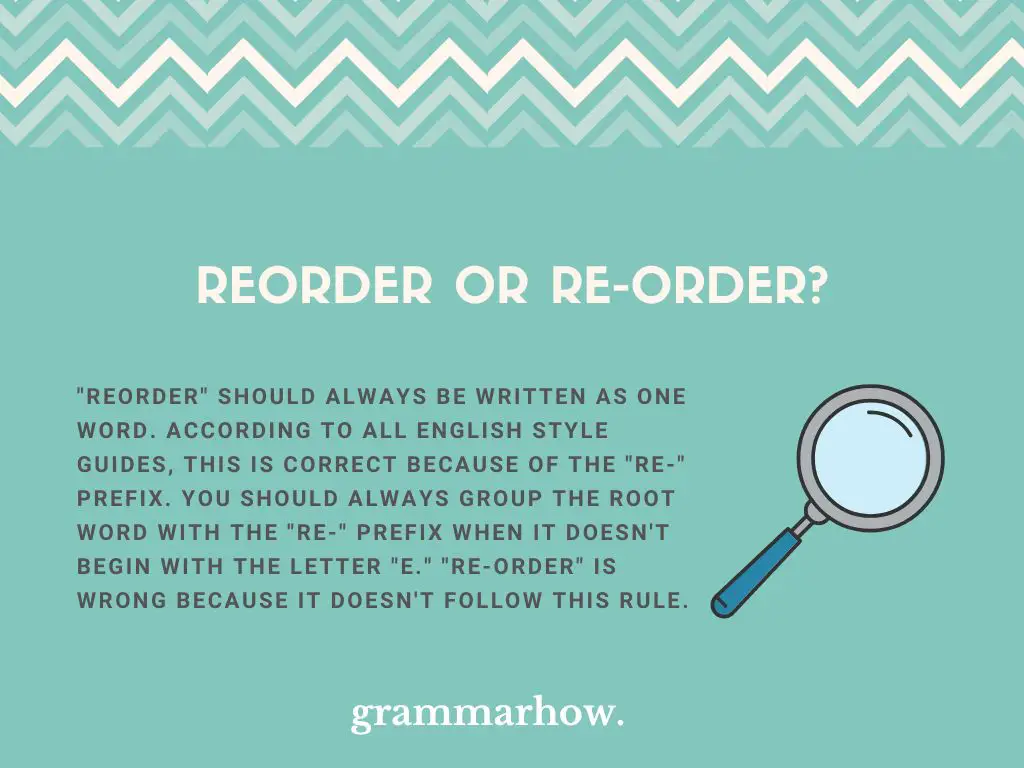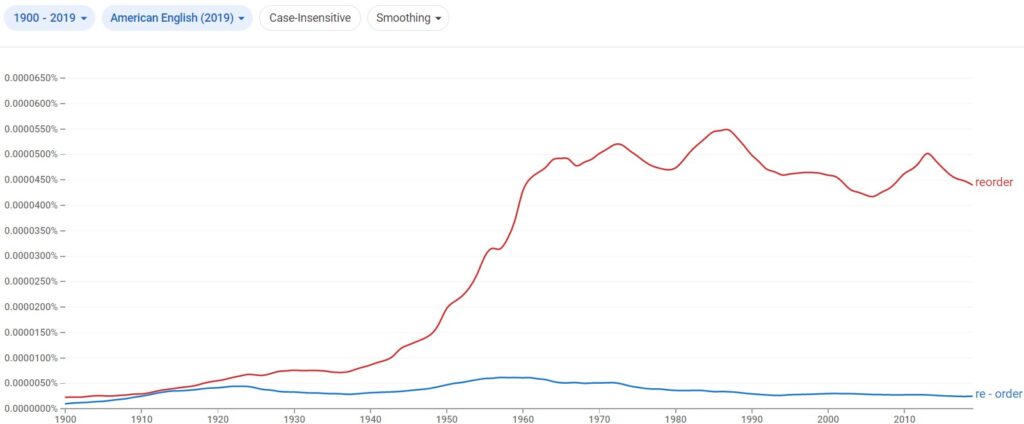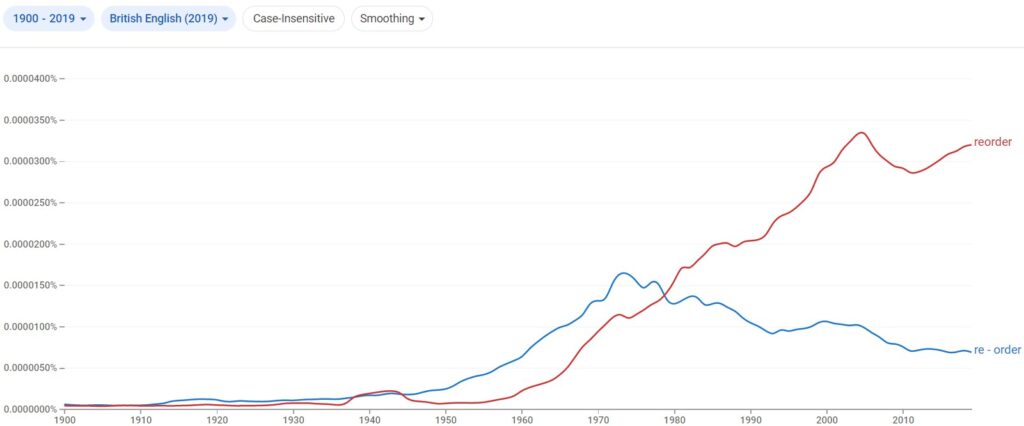Hyphen rules can be tricky to figure out at first glance. It seems like different words and phrases follow different rules. This article will explore how to use “reorder” and “re-order.” It would help to know whether it’s one or two words and where the hyphenated form comes into play.
Reorder or Re-order?
“Reorder” should always be written as one word. According to all English style guides, this is correct because of the “re-” prefix. You should always group the root word with the “re-” prefix when it doesn’t begin with the letter “e.” “Re-order” is wrong because it doesn’t follow this rule.

AP Style and The Chicago Manual of Style are two great style guides to refer to with this. When hyphenating certain prefixes, these style guides explain most of what you need to know.
Both styles include rules for the “re-” prefix. You should only hyphenate the “re-” prefix with the following word when it begins with an “e” or a “u” (but only if the “u” isn’t pronounced as “you”).
For example:
- Re-entry
- Re-urge
However, in any other case, the hyphen is dropped. Since “order” begins with an “o,” you do not need to hyphenate the word. The same would apply regardless of the letter.
- Reorder
- Reunite (“u” is pronounced like “you” here, so the hyphen is dropped)
- Restrain
Reorder
“Reorder” should always be written as one word. This is because the “re-” prefix comes before a word that begins with “o.”
You should always remove the hyphen with “re-” prefix words unless the following words start with “e” or some “u’s.” This is a fairly easy rule to understand once you’ve come to grips with the basics of “re-” words.
Here are some examples to show you how to use “reorder” in a sentence:
- I’m going to need to reorder most of these documents. Somebody submitted them in the wrong formats.
- I think you should reorder it to see if it arrives on time. There’s no reason for us to wait any longer than necessary.
- Can you not reorder it to your new address? Why are you having to wait so long before this all starts working?
- I will reorder it when I have the money. For the time being, you’re going to have to wait a little longer.
- She should have reordered this months ago. I’m not sure why we’re being made to wait so long for it.
Re-order
“Re-order” should not be hyphenated. It goes against the hyphen rules associated with the “re-” prefix.
Remember, “order” begins with an “o,” which means it should not be hyphenated after “re-.” You should leave the hyphen out because it is not the officially-recognized form.
Some native speakers will hyphenate it, but this is because they do not know the “re-” hyphen rules. It is always due to a mistake on their part rather than a conscious grammatical choice.
Here are some examples to remind you of the correct form:
- Correct: I’m going to have to ask you to reorder this product for us. We need a lot of them ready for the new season.
- Incorrect: She won’t re-order this until it’s safe to do so. I’m not sure when that will be. It’s dependent on the money.
- Correct: I will reorder them later. I don’t have time to do the reordering now, I’m afraid.
- Incorrect: What can I do to help? If you need me to re-order anything for you, just say the word, and I’ll do it.
Re order
“Re order” is never correct as two words. You should never remove the grouping of the words because “re-” is a prefix word.
Prefix words often can’t stand as their own word. Therefore, including a space after “re” stops it from making any sense in the sentence.
Here are some examples to show you how to use it correctly:
- Correct: I’m going to need to reorder the parcel. I don’t see why they’ve waited this long to send it out to me.
- Incorrect: You should try to re order it. I doubt it’ll help you that much, but it’s worth looking into it, just in case.
- Correct: I’ll never be able to reorder it now. The product is out of stock everywhere. I hate that I missed out on this chance.
- Incorrect: If I can re order it in time, then you’ll have it before Christmas. There’s a lot of pressure on this situation now, though.
Reorder or Re-order in the UK vs. US?
Sometimes, there are slight geographical differences between the spellings of words. You might find that one language uses the hyphen while another does not (even if they come from the same root).
According to Google Ngram Viewer, “reorder” is the most popular choice in American English. The hyphenated form is barely used, showing that the usual rules are followed when using the prefix “re-.”

“Reorder” is also the most popular choice in British English. “Re-order” is slightly more popular here but is still not recognized as the correct variation.

Both American and British English use “reorder” without the hyphen. This matches the “re-” hyphen rules that come when the following word starts with any letter besides an “e” (and some “u’s”).
Re-order or Re-Order?
“Re-order” and “Re-Order” both appear in certain title styles. Hyphen forms can be capitalized differently, depending on which style you write with.
According to AP Style and The Chicago Manual of Style, “Re-Order” should have both sections capitalized. This helps to keep it in line with the rest of the title (where most words other than prepositions are capitalized).
According to the APA Style guide, “Re-order” is the best choice for titles. You should not capitalize the second part of the hyphen because it counts as one word. Only the first letter should be capitalized.
Final Thoughts
“Reorder” is the only form you should use in your writing. It is correct to write it as one word because of the “re-” prefix. You should only hyphenate the “re-” prefix when the word it comes before starts with an “e” or “u.” “Re-order” is never correct.

Martin holds a Master’s degree in Finance and International Business. He has six years of experience in professional communication with clients, executives, and colleagues. Furthermore, he has teaching experience from Aarhus University. Martin has been featured as an expert in communication and teaching on Forbes and Shopify. Read more about Martin here.
